
|
|

|
YOU ARE HERE>>REAL or FAKE>>Auction houses make mistakes too
The experts at the auction houses are not infallible!
Neither are museum academics.
Experienced dealers see more genuine and faked artifacts than any museum or auction house does.
![]()
From portland
27th September 05
Bonhams have a piece of glass in auction described as 18th Dynasty with an incised cartouche of Amenhotep lll 14th century BC which they estimate at a surprisingly low £1600/1800
Bonham's image is copyrighted but we have here a pic from the catalogue.http://www.bonhams.com/cgi-bin/public.sh/pubweb/publicSite.r?sContinent=EUR&screen=lotdetailsNoFlash&iSaleItemNo=2593387&iSaleNo=11598&sServer=http://images1.bonhams.com/&sPath=2005-08/18/7123611-29-1.jpg
Even a moderately experienced ancient glass collector would know that 18th Dynasty glass is about as rare as it gets and intact 18th Dyn almost unseen and intact 18th Dyn with an inscribed cartouche is unique.
There have been about 20 of these cups all coming to the market in the last 10 years. Nothing before that, and none in any old established museum collections or publications.
I bought one about 10 years ago for about £12,000 and showed it to an Egyptologist who didn't like it at all and said the inscription was nonsense.
I then took it to the B.M. who almost laughed at it. I returned it to the dealer saying that if he could get a written statement from a recognised Egyptologist that this was authentic I would keep the piece notwithstanding what the B.M. had said.
The dealer had an Egyptologist visiting him that week and promised to get such a statement. However in the event the Egyptologist (a famous one) condemned the piece and the dealer returned the piece to source.
They are definitely made of glass but almost certainly in modern times. The interesting thing is how they get the enamel like Patina. I would love anybody who knows the technique to explain it to us.
Remember, you saw it first here!
Another quite famous![]() fake that slipped through and was offered at auction by an entirely respectable source.
fake that slipped through and was offered at auction by an entirely respectable source.
![]()
Some responses on the two yahoo discussion groups
slightly edited so that it should make some sense in this contect
September 2005
From Andy
Sorry to disagree with you but this cup is absolutely authentic and of the stated period. though, as stated in the listing, it is repaired and restored.
You don't need anyone to search for you in catalogues, the description of Bonham's clearly states it was in their auction in November 2001.
If we should judge items by the fact that they were previously in auctions, sold or unsold, then half of all antiquities in collections, museums and big galleries must be also questionable.
You say you know of at least twenty of these cups showing up in the last 10 years? I would put the number to 200, faience included. Does the number make them fake?
Glass, not faience, faience cups are not that rare.
From Alexander
It was offered before, infact it was in theMay 2003 sale, lot 63, estimate 2,200 to 2,600 pounds:
All the best with your back; I hope you'll be upagain soon, and be able to go to Bond Street yourself to tell Chantelle what you thinka bout this piece.
Do spare Joanna a bit, she isexpecting a baby.
From Jason
As Alexander pointed out this jar was also listed in the May 2003 sale (it went unsold) which is NOT mentioned in the new auction listing. Credit goes to Alexander for the spot. 2001 listing in the description of the current lot. :-)
So, listed at least three times in four years through Bonhams alone.
Not scandalous, but interesting -- if no one was spotting a problem with it, I would be surprised to see such a high turnover on a piece that is uncommon and has been priced at reliably low estimates. I've never handled a similar piece, so I can't comment much on the authenticity myself.
Andy, don't confuse faience with glass. Faience, frits, and glass are all quartz-based materials, but different procedures are used to make all three and they differ physically in the amount of alkali in the mix. Very few glass objects are found in Egypt prior to the New Kingdom, and during Amenophis III's reign most raw glass would have probably still been an expensive import. According to Nicholson, glass making from scratch probably didn't occur in Egypt until Akhenaten's reign a few decades later.
From Alexander
I have not checked the object in 2003, so I only have the photograph to look at. When you zoom in on it the patina looks convincing (but then again, one cannot zoom in enough).
The inscription is not too clear either; what are the signs below the cartouche? I can think of two translations, but in both cases there is a wrong sign. Maybe there is more text than the image reveals.
Typically something to check with the object in hand.
I agree with you that - if authentic - it is a bargain at that price.
But I will stay away from it.
From portland
I am glad to be able to stimulate such a discussion as in the long run the collectors will benefit enormously.
To deal with his points:
- It certainly doesn't mention anything about repair or restoration in the current listing. In the first listing in Nov 2001 it did but by the time of the second listing in May 2003 it only says restored and by the time of the current listing no mention of any repair or restoration at all, which can't be an accident. Also in each of the three listings the estimate has gone lower and lower and as Jason said "I would be surprised to see such a high turnover on a piece that is uncommon and has been priced at reliably low estimates" .
- I think Andy missed the fact that we were talking about 2003 (unsold) and not 2001. Do you have a record of what it sold for or if it sold in 2001?, the results on Bonhams site don't appear to go back that far. I wonder if it did sell in 2001. My feeling is that it probably didn't. In the description May 2003 it doesn't mention anything about it being in the 2001 sale .
- I knew it had been in the 2003 sale, when I said to you that it had been in an earlier sale, and thought I had told you that but now see I omitted to put in the date. Andy also fails to appreciate just what a huge difference there is between pure glass and faience.
- Jason is correct that the earliest know 18th Dynasty vessels, as against beads, from archaeological excavations occur only from the time of Akhenaten. That is why, I repeat, such a glass vessel with such Cartouche would be the earliest ever and would be unique and the price much much higher. Look at any other form of 18th Dyn glass sold at auction and you will get the picture, even for fragments and of later dates .
- If the piece were not a forgery I know a lot of major collectors and museums that would have bought it for a lot lot more than the estimate, including myself. How come the Metropolitan or Corning don't have one in their collections when 20 or so have been around in the last 10 years at bargain prices? The conclusion is obvious.
- I am still waiting for someone to tell us how such a patina could be created on a modern object. Is it just calcium in this case? In fact the subject of false patinas, of all kinds, and on all kinds of antiquities, is of vital interest to us all and I would like to see a wide ranging discussion on the subject. We need the input of chemists and scientists. It is through such knowledge and scientific process that they have recently been able to discredit inscriptions on major objects in Israel including the famous Ivory Pomegranate from the first temple period and also the Joseph Ossuary. Too often when I've asked people how false patinas are created they simply try to suggest it as some acid treatment but that is not an answer.
A copy of
BRITISH MUSEUM - Bimson and Freestone
Early Vitreous Materials. 1992 191 pages with numerous b/w illus, drawings, charts,maps and tables. This combines various papers on the subject of early vitreous materials and includes:Early Faience Glass and glazed materials Egyptian Blue Minoan faience 18th Dynasty faience
![]()
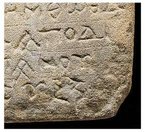
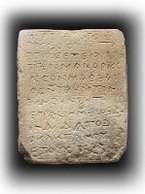
From Alexander
September 29th 2005
Speaking of Bonhams, also look at their lot 359:
This is supposed to be a sandstone slab, inscribed with a "Greek", "Gnostic", "indecipherable" text from the "6th-4th century BC" ("or later").
Apart from the obvious question ("how do you know it is Gnostic if you cannot decipher it?") it is clear that their description is wrong.
- It is not a Greek text, but Coptic.
- This makes it a much younger stone, 1,000 years at least (more thantheir "or later" implies)
- It is not indecipherable at all (although the image provided makesit hard to read the lower part of the text; better light would help)
- It is not Gnostic. It begins with "the day of commemoration for ourblessed brother, who is at rest ..."; his name escapes me, due to the poor lighting.
- Note the 3 crosses in line 1, and inbetween two times two letters, ICand XC. This is an abbreviation for "Jesus Christ", a very commonphenomenon in Coptic Christian monuments and manuscrips. This alone makes it clear that the dating in the catalogue is wrong.
From Alexander
October 5th 2005
Hello all, Just heard back from Bonhams about this. This is what they wrote: --------------------------------- Dear Mr Biesbroek, Thank you for your email. The information about lot 359 is very interesting. We struggled to decipher this text and as it had some Greek letters in it, we and the British Museum (!) thought it must be Greek. I have emailed a copy of the picture to our Egyptian specialist and they have also confirmed that it is definately Coptic text, so I have changed the date and description and added it as a saleroom amendment on the website. Thank you for your help with this! kind regards and thanks again Chantelle --------------------------------- Congratulations! I wonder if they will review their opinion of the glass cup? ............................................................................................................. Hello Joanna and Chantelle, Good idea for you to keep up to date on this section of my website! Your contributions to these and other discussions about antiquities would be most welcomed. |
..............................................................................................................
![]()
October 6th
Description changed to:
Lot Notice
This lot has been incorrectly catalogued and dated. The description should be as follows: A Coptic inscribed sandstone slab, circa 4th-7th Centuries A.D., inscribed with eleven lines of Coptic text, possibly beginning with "the day of commemoration for our blessed brother, who is at rest....", also containing an abbreviation for "Jesus Christ" in line 1, composed of the letters IC and XC between three crosses.
They say that the text "possibly" translates as (etc)..............
Possibly?!
Alexander teaches the language for goodness sakes!
The translations given to them are correct.
It isn't a complete tranlation simply because Alexander cannot see the lower half of the text properly in the image.
![]()
This is from Michel van Rijn (suitably edited to avoid legal problems!)
The alert buyer hit the jackpot six times by acquiring lot number 206, consisting of six fabulous Egyptian rings for £800. Not even letting the ink on the invoice get dry, the buyer consigned one of the rings to Christie's New York. New York ancient jewellery expert Max Bernheimer showed it to the erudite academic Dr. Jack Ogden who authenticated it, after which Maxie catalogued it as a highly important stirrup ring of the era of Akhenaton.
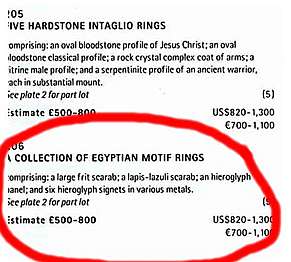
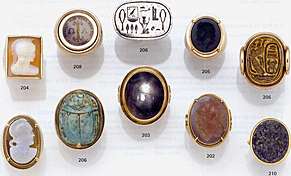
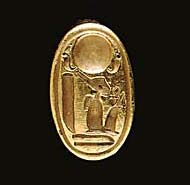
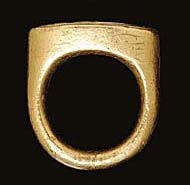
An Egyptian gold stirrup ring, New Kingdom, Dynasty XVIII, 1353-1335 BC
Sold for $354,700
December 2003
New York, Rockefeller Center


Home | About This Site | Privacy Statement | Gallery | Testimonials | Guarantees
About Collectors' Resources pages | What's New
Search | Site Map | Contact Us
 Next page
Next page